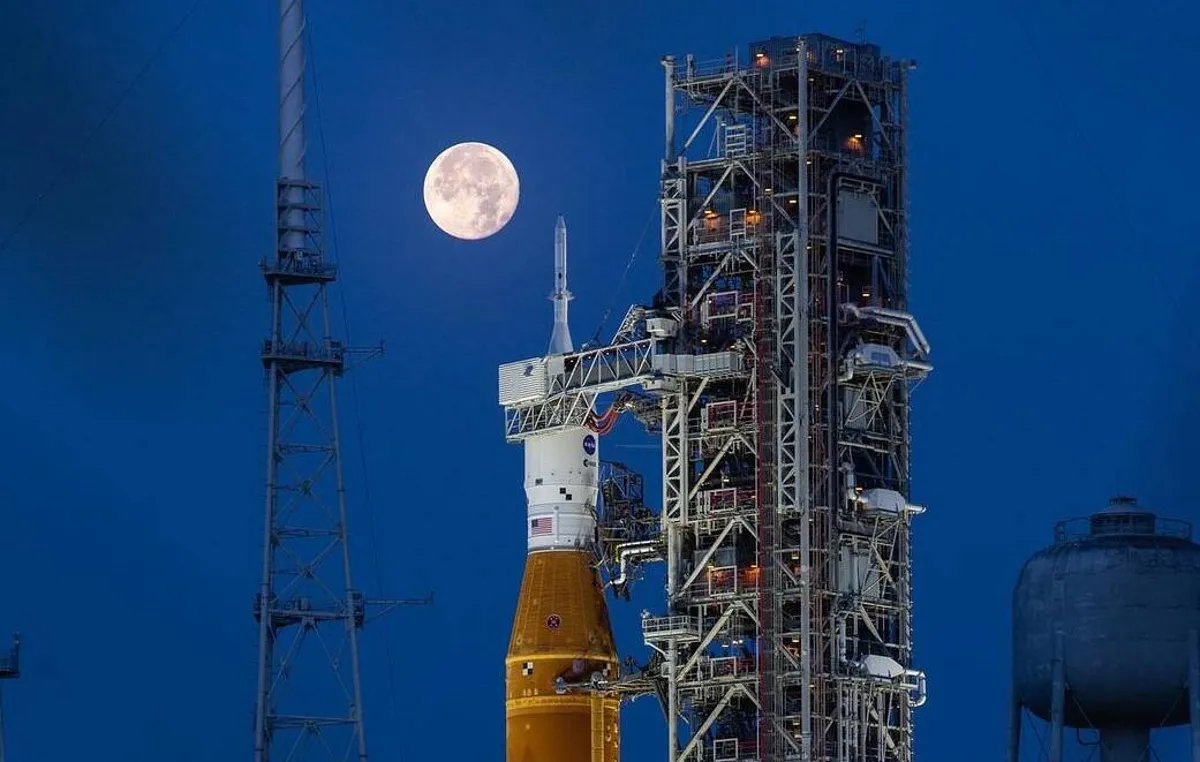The technical problems causing the hydrogen leak in the core stage fuel tanks of NASA’s Space Launch System are anticipated to take “many weeks” to resolve.
After engineers failed to stop a hydrogen leak that occurred during loading propellants into the rocket’s core stage fuel tanks, NASA decided to abort its second attempt to launch the Artemis 1 mission into lunar orbit early on Saturday. NASA is unlikely to make a third launch attempt in September after the second effort failed.
According to NASA, the liquid hydrogen fuel feed line interface with the Space Launch System (SLS) rocket is where the hydrogen leak happened. A single voyage to the Moon using the Orion spacecraft, people, and supplies is only possible with the SLS.
The second launch of the Artemis 1 mission, an unmanned test, was scheduled for Saturday at 2:17 PM ET (11:17 AM PT) from Florida’s Kennedy Space Center.
The Boeing-made SLS core stage has a diameter of 27.6 feet and a height of 212 feet (64.6 metres) (8.4 meters). It keeps the systems for supplying the stage’s four R2-25 engines as well as cryogenic liquid hydrogen and liquid oxygen.
Astronauts will be returned to the Moon and beyond as part of the multi-stage Artemis programme. The first woman and person of colour will set foot on the moon during the Artemis mission.
A previous launch attempt on August 29 by NASA’s Artemis mission team was aborted because engineers were unable to cool all four RS-25 engines to minus 420 degrees Fahrenheit (-250 degrees Celsius), which is required to prevent damage to the core stage during the eight-minute trip to low-Earth orbit. The core stage separates from the upper stage and the Orion spacecraft once it has reached low-Earth orbit.
According to NASA, one of the four engines showed greater temperatures than the others during the second launch attempt. Prior to the passage of extremely cold liquid hydrogen into the rocket’s core stage, the so-called “bleed test” is conducted.
Engineers also found a hydrogen leak on a “purge can” during the initial launch attempt, but they were able to control it at that point by manually altering propellant flow rates.
After the failed attempt to launch the Artemis 1 mission on Saturday, NASA acknowledged that it made three attempts to stop the leak.
“The 8-inch line used to fill and drain liquid hydrogen from the SLS rocket was found to be leaking in a space between the ground side and rocket side plates. The seal could not be resealed after three tries “In a Saturday night update, NASA stated.
NASA is looking into the possibility that a “accidental command” made during the initial stages of loading hydrogen briefly increased system pressure and may have been a factor in the faulty seal.
“A mistaken command was accidentally sent that momentarily increased the pressure in the system while in the initial stage of hydrogen loading operations known as chilldown, when launch controllers cool down the lines and propulsion system prior to flowing super cold liquid hydrogen into the rocket’s tank at minus 423 degrees F. Engineers are looking into the problem, even though the rocket was safe and it is too soon to say whether the increase in pressurisation was a factor in the leaky seal’s cause “NASA stated.
NASA’s newest tiny, powerful laser may be able to detect water on the Moon.
Charlie Blackwell-Thompson, the director of the Artemis launch, made the decision to scrap the second attempt at about 11:17 a.m. ET, or nearly three hours before the launch window on Saturday was scheduled to open.
NASA had scheduled a backup launch for this week’s Monday or Tuesday, according to Reuters, but later decided it would take longer to fix the fresh hydrogen leak. Jim Free, associate NASA administrator, stated during a media briefing that the following window is between September 19 and 30, or there may be another opening in October.
The manager of NASA’s Artemis project, Mike Sarafin, estimated that it would take “several weeks of work” to fix the existing technical problems. Any launch could be delayed until the middle of October if this requires bringing the SLS back to the assembly facility.
There are 11 launch chances between October 17 and October 31 according to NASA’s Artemis mission availability website. There are four important requirements that must be fulfilled before the rocket may launch.
In order for the upper stage of the SLS rocket to time the trans-lunar injection burn to intercept the “on ramp” for the lunar far retrograde orbit, the launch day must take into account the Moon’s position in its lunar cycle.
In order for the solar array wings to be able to capture sunlight and turn it into electricity, the resulting trajectory must make sure Orion is not in the dark for longer than 90 minutes at a period.
It must support a trajectory that enables the “skip entry” manoeuvre that will be used by Orion on its return to Earth, in which the spacecraft will dip into the upper atmosphere, slow down, then skip out of it before returning for the final descent and splashdown.
To make it simpler to recover Orion from the Pacific Ocean, the launch date must result in a daytime splashdown for the spacecraft.








